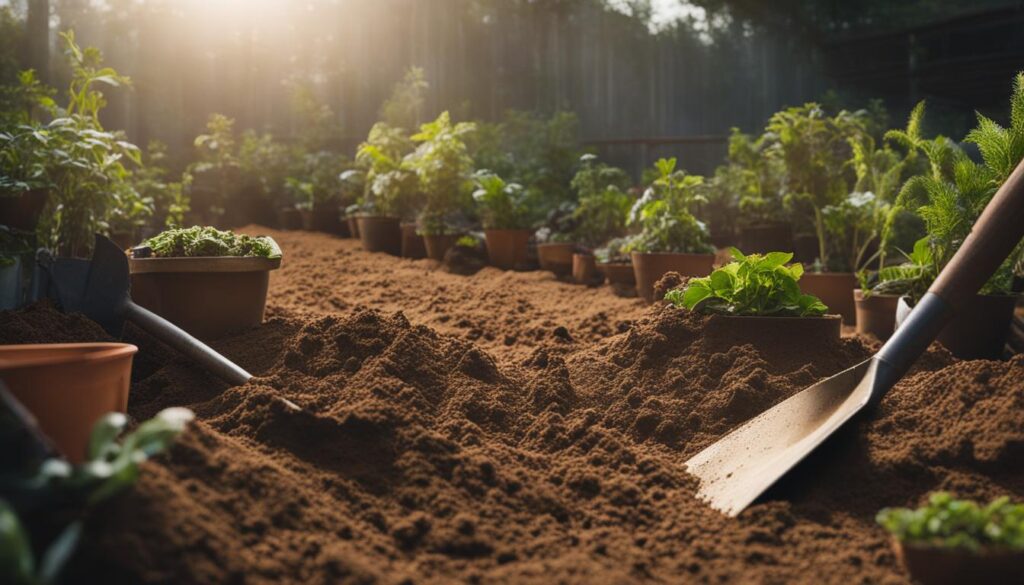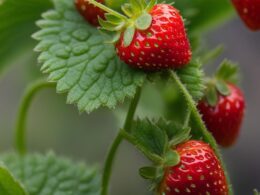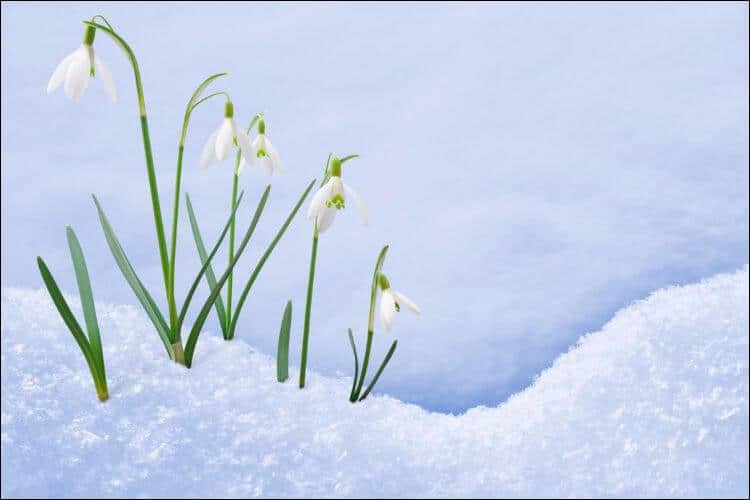Are you wondering if it’s possible to grow plants in sandy soil? The answer is yes! Contrary to popular belief, sandy soil can actually provide a solid foundation for certain plants. While it may not hold water or nutrients as well as other soil types, with the right knowledge and techniques, you can create a thriving garden in sandy soil.
Sandy soil is known for its good drainage and easy digability. However, it tends to dry out quickly, leach nutrients, and be slightly acidic. But don’t worry, there are ways to improve sandy soil and make it more suitable for plant growth. By adding organic material and implementing moisture retention techniques, you can create a fertile environment for a variety of plants.
Post Summary:- Growing plants in sandy soil is possible with the right knowledge and techniques.
- Sandy soil has good drainage but doesn’t hold water or nutrients well.
- You can improve sandy soil by adding organic material and enhancing moisture retention.
- There are several plants that thrive in sandy soil, such as sedum, lavender, and carrots.
- Horticultural sand is the best type of sand for plant growth in sandy soil.
Now that you know the possibilities of growing plants in sand, let’s dive deeper into understanding sandy soil and discovering the plants that can thrive in it.
Understanding Sandy Soil
Sandy soil is a unique type of soil that has distinct characteristics and composition. Understanding these attributes is essential for successfully gardening in sandy soil and maximizing plant growth. Sandy soil is characterized by its light brown color and grainy texture. It is composed of large particles that create gaps, leading to poor moisture and nutrient retention for plant roots. This type of soil provides excellent drainage but tends to dry out quickly, making it challenging for plants to thrive.
When performing a simple soil test, you can confirm if you have sandy soil by observing its behavior when dampened. Sandy soil will crumble and fall apart easily. Its inability to clump and hold together is a clear indicator of its sandy composition. Additionally, sandy soil tends to be more acidic, which can impact the availability of essential nutrients for plants.
To summarize, sandy soil has the following characteristics:
- Light brown color and grainy texture
- Large particles that create gaps
- Poor moisture and nutrient retention
- Excellent drainage
- Tendency to dry out quickly
- Acidic pH levels
Understanding the unique attributes of sandy soil is the first step towards successful gardening in these conditions. Its grainy texture and poor moisture retention can be challenging, but with proper techniques and plant selection, you can create a thriving garden in sandy soil.
| Sandy Soil Characteristics | Soil Types | Soil Composition |
|---|---|---|
| Light brown color and grainy texture | Sandy soil | Large particles that create gaps |
| Poor moisture and nutrient retention | Loamy soil | Medium-sized particles with a mixture of sand, silt, and clay |
| Excellent drainage | Clay soil | Small particles that compact tightly, leading to poor drainage |
| Tendency to dry out quickly | Peaty soil | High organic matter content from decomposed vegetation |
| Acidic pH levels | Chalky soil | High calcium carbonate content, resulting in alkaline conditions |
Understanding the composition and characteristics of different soil types can help you identify the specific qualities of your sandy soil. By knowing the limitations and advantages of sandy soil, you can take appropriate measures to improve it and select plants that are well-suited for these conditions.
Plants That Thrive in Sandy Soil
If you have sandy soil in your garden, don’t despair! There are plenty of plants that actually thrive in these conditions. Sandy soil can provide excellent drainage, and by choosing the right plants, you can create a beautiful and vibrant sandy garden. Here are some examples of plants that are well-suited for sandy soil:
- Sedum: This drought-resistant ground cover plant features fleshy leaves and small, brightly colored flowers that attract pollinators.
- Lavender: A perennial herb that loves sandy soil and requires good drainage. It produces beautiful flowers and has a delightful aroma.
- Artemisia: A fast-growing groundcover with soft, finely-cut leaves that release a soothing fragrance when brushed.
- Carrots: These biennial vegetables prefer sandy soil as it allows them to easily burrow and grow deep into the ground.
These plants have adapted to sandy soil and can thrive in these conditions. They have unique characteristics that make them suitable for growing in sandy gardens. For example, sedum and lavender are both drought-resistant, which makes them perfect for sandy soil that doesn’t hold water well. Artemisia’s soft leaves and pleasant fragrance make it an attractive option for sandy gardens.
Carrots, on the other hand, benefit from the loose texture of sandy soil, allowing their roots to grow freely. By selecting these plants, you can create a thriving garden in sandy soil and enjoy the beauty they bring to your landscape.
Comparison of Plants That Thrive in Sandy Soil
| Plant | Main Characteristics |
|---|---|
| Sedum | Drought-resistant ground cover plant with fleshy leaves and attractive flowers |
| Lavender | Perennial herb with beautiful flowers and a pleasant aroma |
| Artemisia | Fast-growing groundcover with soft leaves and a soothing fragrance |
| Carrots | Biennial vegetable with a taproot that grows well in loose, sandy soil |
These plants are just a few examples of the many options available for sandy soil gardens. It’s essential to consider the specific needs of each plant and provide the necessary care, including regular watering and appropriate fertilization. With the right selection and proper maintenance, you can create a thriving garden that showcases the beauty of plants that are well-adapted to sandy soil.
How to Improve Sandy Soil for Plant Growth
Improving sandy soil for optimal plant growth requires specific techniques and amendments. By addressing the challenges of poor moisture retention and nutrient deficiency, you can create a more fertile environment for your plants. Here are some effective methods to enhance sandy soil:
- Mix in Organic Matter: Adding organic material such as compost, aged manure, coconut coir, leaves, and wood ash can significantly improve sandy soil. These organic amendments help increase moisture retention, enhance nutrient content, and promote beneficial microbial activity.
- Add Fertilizer: Sandy soil tends to lack essential nutrients needed for plant growth. Supplementing the soil with a balanced fertilizer rich in nitrogen, phosphorus, and potassium (NPK) can provide the necessary nutrients. Granular fertilizers are recommended for sandy soil, and foliar application can be beneficial for faster nutrient uptake.
- Add a Top Layer of Mulch: Applying a layer of organic mulch on the surface of sandy soil can help conserve moisture, suppress weeds, and regulate soil temperature. Additionally, as the mulch breaks down, it contributes to the organic matter content of the soil, further improving its fertility.
- Plant Cover Crops: Sowing cover crops like ryegrass, hairy vetch, crimson clover, or alfalfa can improve sandy soil quality. These plants help prevent erosion, add organic matter when tilled under, and fix nitrogen from the atmosphere, enriching the soil with nutrients.
Implementing these practices will gradually transform sandy soil into a more favorable environment for plant growth. However, it’s important to note that improving soil quality is an ongoing process that requires consistent care and monitoring. Regular soil testing will help you assess nutrient deficiencies and adjust your soil improvement methods accordingly.
Example Table: Comparison of Soil Amendment Options
| Soil Amendment | Benefits | Considerations |
|---|---|---|
| Compost | Increases organic matter, improves moisture retention, enhances nutrient availability | May require frequent applications |
| Aged Manure | Rich in nutrients, boosts microbial activity, improves soil structure | Should be well-composted to avoid weed seeds and excess salts |
| Coconut Coir | Enhances moisture retention, improves soil structure, sustainable option | May require buffering for pH adjustments |
| Leaves | Increases organic matter, promotes nutrient cycling, improves soil structure | Should be shredded or composted before use |
| Wood Ash | Raises soil pH, adds potassium and trace elements | Use sparingly as excessive application can raise pH levels too high |
Each soil amendment option has its own benefits and considerations. It’s essential to assess your specific soil needs and choose the amendments that will best address them. Experimentation and observation will help you determine which combination of amendments works best for your sandy soil conditions.

Best Type of Sand for Plant Growth
If you’re looking to grow plants in sandy soil, choosing the right type of sand can make a significant difference. Horticultural sand is considered the best option for promoting plant growth in sandy soil. Compared to other sands, horticultural sand offers better drainage and is composed of larger particles that allow for easier root penetration.
“Horticultural sand provides a suitable growing medium for plants in sandy soils.”
By using horticultural sand in your sandy soil, you can create an environment that allows plants to thrive. The improved drainage helps prevent waterlogged roots, while the larger particles enable better aeration and nutrient uptake. With these advantages, your plants will have a better chance of establishing strong root systems and reaching their full potential.
When incorporating horticultural sand into your sandy soil, it’s important to mix it thoroughly to ensure an even distribution. Aim for a ratio of approximately 25% horticultural sand to 75% sandy soil. Work the mixture into the top layer of soil, taking care not to damage any existing roots. This will help improve the overall structure and fertility of the soil, creating a more favorable environment for plant growth.
| Sand Type | Drainage | Particle Size | Root Penetration |
|---|---|---|---|
| Sandy Soil | Variable | Small | Limited |
| Horticultural Sand | Excellent | Large | Easy |
Using horticultural sand in your sandy soil can be a game-changer for your plants. It provides the right balance of drainage and aeration, allowing roots to access water and nutrients without becoming waterlogged. By creating an environment that closely resembles well-drained soil, horticultural sand can help your plants thrive despite the challenges of sandy soil.

Choosing the Right Horticultural Sand
When selecting horticultural sand for your plants, it’s important to choose a reputable supplier that offers high-quality sand. Look for sand that is specifically labeled as horticultural or sharp sand, as these types are usually suitable for plant growth. Avoid using sand that is intended for construction or play, as it may contain contaminants or have inconsistent particle sizes.
In conclusion, horticultural sand is the best option for promoting plant growth in sandy soil. Its excellent drainage properties and larger particle size make it easier for roots to penetrate and access air and nutrients. By incorporating horticultural sand into your sandy soil, you can create a more favorable environment for your plants to thrive. Happy gardening!
Is it Possible to Grow Corn in Sandy Soil?
Growing corn in sandy soil can be challenging, but with the right techniques, it is possible. One effective method is using raised beds. By creating raised beds, you can improve the soil’s water retention and nutrient levels. Additionally, amending the sandy soil with organic matter helps enhance fertility. Following these tips on how to grow corn in raised beds can lead to successful corn cultivation in sandy soil.
Conclusion
In conclusion, while gardening in sandy soil can pose some challenges, it is definitely possible to cultivate a thriving garden with the right approach. By selecting plants that are well-suited to sandy conditions, improving the soil quality through the addition of organic matter, and implementing proper watering and fertilization techniques, you can create a beautiful and successful garden.
Remember to consider the unique needs of each plant and provide the necessary care and attention. Some plants, such as sedum, lavender, and carrots, thrive in sandy soil and can bring beauty and productivity to your garden.
To enhance the quality of your sandy soil, mix in organic matter like compost or aged manure, add a top layer of mulch to conserve moisture, and consider growing cover crops to boost nutrient levels. These methods will help improve the soil structure, moisture retention, and nutrient content.
With these strategies in place, you can overcome the limitations of sandy soil and create a thriving garden full of lush greenery and vibrant blooms. So roll up your sleeves, get your gardening tools ready, and enjoy the rewards of your efforts in transforming sandy soil into a flourishing oasis. Happy gardening!
Can Plants Grow in Sand Even in Shaded Areas?
Yes, growing cherry tomatoes in shade is possible, but the soil type is crucial. Plants can grow in sand, even in shaded areas, as long as they receive adequate nutrients and water. Adding organic matter and using a slow-release fertilizer can improve the soil’s fertility and support plant growth.
FAQ
Can plants grow in sandy soil?
Yes, certain plants are well-adapted to sandy soil and can thrive in these conditions.
What are the characteristics of sandy soil?
Sandy soil is light brown, feels grainy, has good drainage, but doesn’t hold water or nutrients well. It also tends to be acidic.
Which plants can grow in sandy soil?
Some plants that thrive in sandy soil include sedum, lavender, artemisia, carrots, potatoes, radishes, cucumbers, red chokeberry, and butterfly bush.
How can I improve sandy soil for plant growth?
You can improve sandy soil by adding organic matter, such as compost and aged manure, using a balanced fertilizer, applying a top layer of mulch, and planting cover crops.
What is the best type of sand for plant growth in sandy soil?
Horticultural sand is considered the best type of sand for plant growth in sandy soil, as it offers better drainage and easier root penetration.
Can I grow a thriving garden in sandy soil?
Yes, by selecting the right plants, improving the soil with organic matter, and implementing proper watering and fertilization techniques, you can create a thriving garden in sandy soil.









